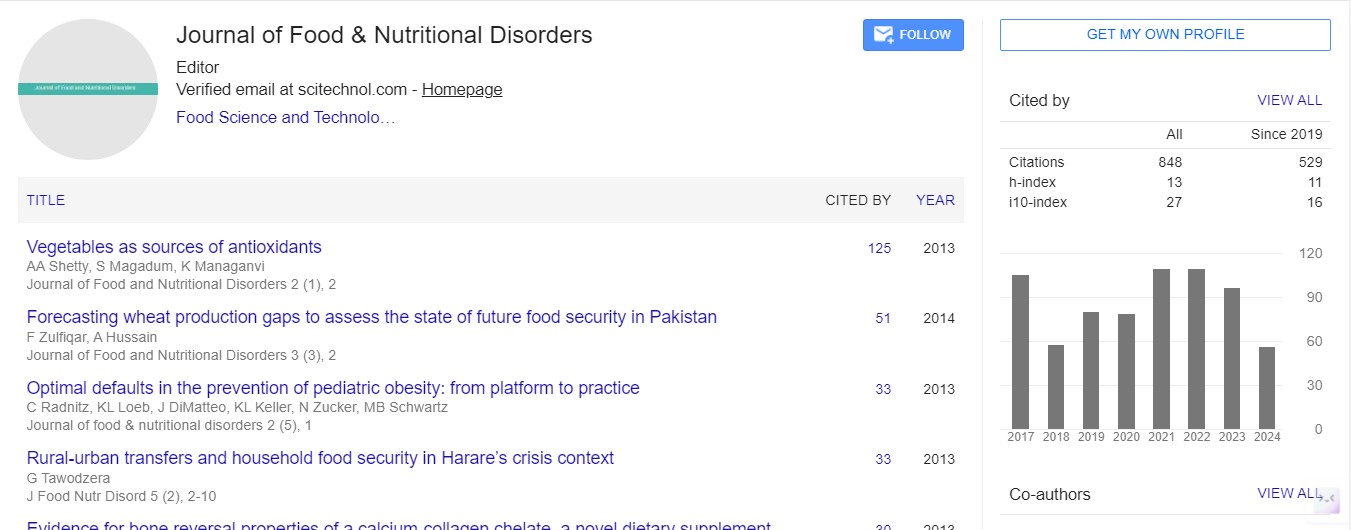The use of plant bioactives to control and eradicate multi-species biofilms containing Listeria monocytogenes
Alexa Jollimore, Rafael Garduno and H P Vasantha Rupasinghe
Dalhousie University, Canada
Canadian Food Inspection Agency, Canada
: J Food Nutr Disor
Abstract
Statement of the Problem: Biofilms are a microbial protective mode of living, enabling microorganisms to survive adverse environmental conditions. Biofilms enhance L. monocytogenes persistence, which could result in product recall and potentially lead to listeriosis outbreaks. Effective biofilm removal typically requires mechanical treatments, therefore, interest in substances that prevent and remove biofilms is increasing. Plant secondary metabolites such as essential oils are of interest as they show nonspecific antibiofilm properties.
Methodology: Dose-response curves of L. monocytogenes against essential oils and selected plant phenolic compounds were obtained. Growth kinetics of biofilms formed on 96-well polystyrene plates filled with 2% M.F. pasteurized milk was determined using the crystal violet assay. To establish biofilms containing listeriae, 2% M.F. pasteurized milk spiked with L. monocytogenes to a final concentration of 100 CFU/ml was used. Mature biofilms were formed using the parameters from the growth kinetics experiment and exposed to plant bioactives (essential oils or single phenolic compounds) at concentrations set according to the dose response curves. Plant bioactives were added in a 0.15% agar solution in dH2O. Exposure periods were 1-h and 5-h. After treatment, the remaining biofilm was measured by the crystal violet assay.
Findings: Tea tree essential oil, thymol, carvacrol and eugenol were able to remove biofilm to baseline levels.
Conclusion & Significance: Plant bioactives were able to disrupt established biofilms containing L. monocytogenes. The compounds identified as active against biofilms will be tested using a commercial milk dispensing equipment to determine whether they eliminate preformed biofilms, and delay re-formation of biofilms after treatment. The ultimate goal is to improve the food safety associated with handling dairy products.
Recent Publications
Stephanovic S, Vukovic D, Dakic I, Savic B and Svabic- Vlahovic M (2000) A modified microtiter-plate test for quantification of staphylococcal biofilm formation. Journal of Microbiological Methods. 40(2):175-179.
1. Kanski J, Aksenova M, Stoyanova A and Butterfield DA (2002) Ferulic acid antioxidant protection against hydroxyl and peroxyl radical oxidation in synaptosomal and neuronal cell culture systems in vitro: structure–activity studies. J Nutri Biochem 13:273-281.
Biography
Alexa Jollimore is pursuing her Graduation at Dalhousie University, Faculty of Agriculture, Department of Plant, Food and Environmental Sciences. She has completed her Bachelor of Science in Agriculture, major in Animal Science with a minor in Molecular Biology and Genetics. Her Master’s research is in collaboration with the Canadian Food Inspection Agency, Dartmouth Lab, Microbiology Research Section. Her research encompasses the use of plant secondary metabolites to improve detection of L. monocytogenes within the food system, as well as the use of these compounds to prevent and eradicate mature biofilms within commercial milk dispensing equipment, for future use in the commercial setting.
E-mail: Alexa.jollimore@dal.ca
 Spanish
Spanish  Chinese
Chinese  Russian
Russian  German
German  French
French  Japanese
Japanese  Portuguese
Portuguese  Hindi
Hindi 
